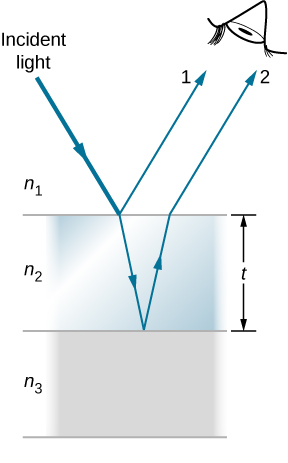| << Chapter < Page | Chapter >> Page > |
The bright colors seen in an oil slick floating on water or in a sunlit soap bubble are caused by interference. The brightest colors are those that interfere constructively. This interference is between light reflected from different surfaces of a thin film; thus, the effect is known as thin-film interference .
As we noted before, interference effects are most prominent when light interacts with something having a size similar to its wavelength. A thin film is one having a thickness t smaller than a few times the wavelength of light, . Since color is associated indirectly with and because all interference depends in some way on the ratio of to the size of the object involved, we should expect to see different colors for different thicknesses of a film, as in [link] .

What causes thin-film interference? [link] shows how light reflected from the top and bottom surfaces of a film can interfere. Incident light is only partially reflected from the top surface of the film (ray 1). The remainder enters the film and is itself partially reflected from the bottom surface. Part of the light reflected from the bottom surface can emerge from the top of the film (ray 2) and interfere with light reflected from the top (ray 1). The ray that enters the film travels a greater distance, so it may be in or out of phase with the ray reflected from the top. However, consider for a moment, again, the bubbles in [link] . The bubbles are darkest where they are thinnest. Furthermore, if you observe a soap bubble carefully, you will note it gets dark at the point where it breaks. For very thin films, the difference in path lengths of rays 1 and 2 in [link] is negligible, so why should they interfere destructively and not constructively? The answer is that a phase change can occur upon reflection, as discussed next.

We saw earlier ( Waves ) that reflection of mechanical waves can involve a phase change. For example, a traveling wave on a string is inverted (i.e., a phase change) upon reflection at a boundary to which a heavier string is tied. However, if the second string is lighter (or more precisely, of a lower linear density), no inversion occurs. Light waves produce the same effect, but the deciding parameter for light is the index of refraction. Light waves undergo a or radians phase change upon reflection at an interface beyond which is a medium of higher index of refraction. No phase change takes place when reflecting from a medium of lower refractive index ( [link] ). Because of the periodic nature of waves, this phase change or inversion is equivalent to in distance travelled, or path length. Both the path length and refractive indices are important factors in thin-film interference.

Notification Switch
Would you like to follow the 'University physics volume 3' conversation and receive update notifications?